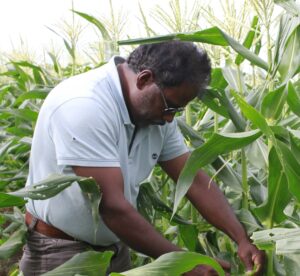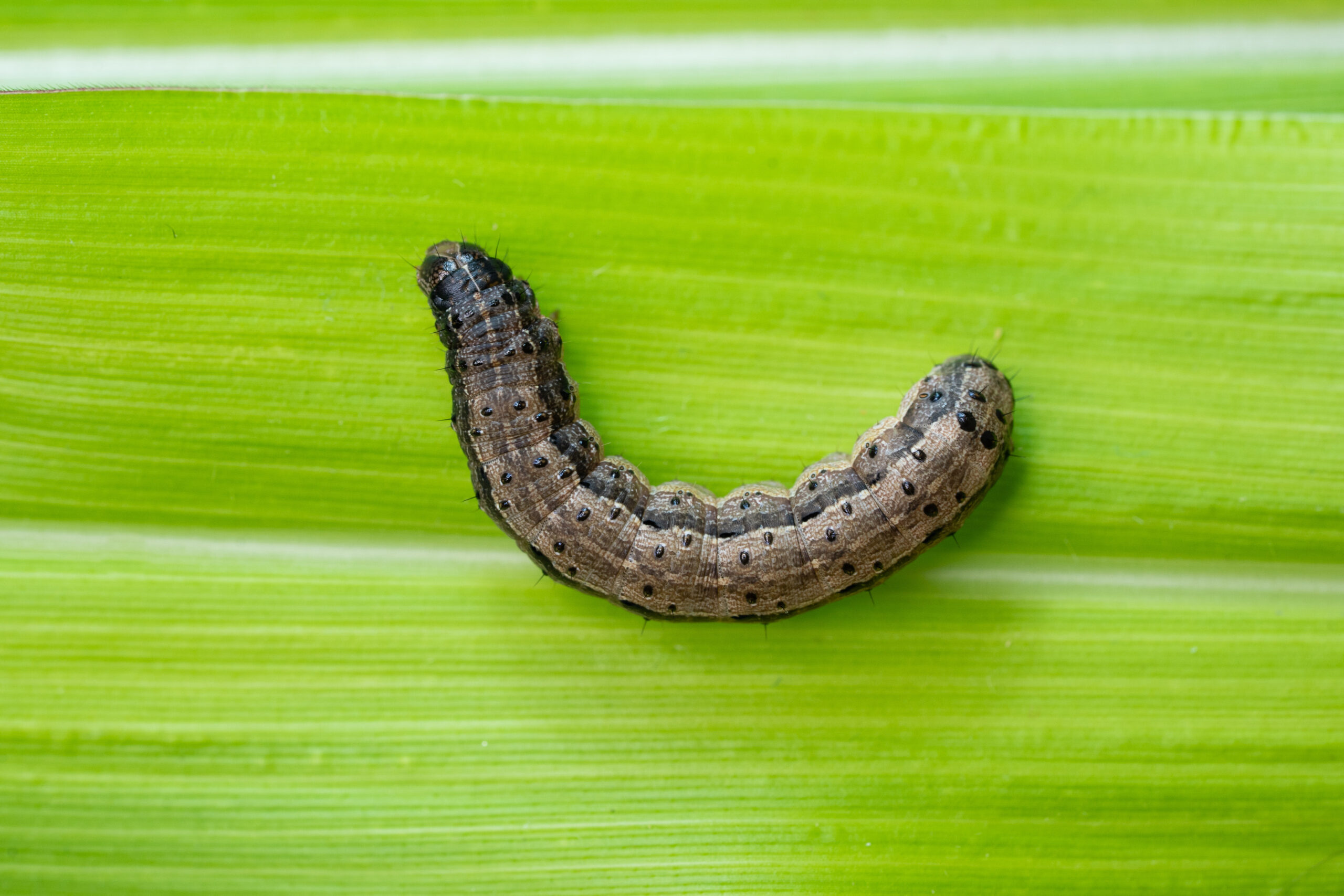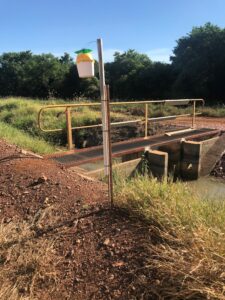Useful tools to manage Fall armyworm developed from DAF research
The levy funded project “Co-developing and extending integrated Spodoptera frugiperda (Fall armyworm) management systems for the Australian vegetable industry” VG20003, has concluded and given industry useful tools to manage the exotic pest and insights into communication and extension methodologies.
The first detection of Fall armyworm (FAW) on Australian shores occurred in early 2020 in Far North Queensland. A known pest overseas, FAW is a destructive migratory pest that is a high risk to the sweetcorn and maize industry, and has also been detected in capsicum, cabbage, eggplant and melons.
From that first detection, FAW has now spread and established in other regions of Queensland, New South Wales, Northern Territory, Western Australia and Victoria.
The project’s aim was to develop a strategy for affected regions and for other regions that develop an incursion. The outcomes were then to understand the FAW biology, seasonal patterns, lifecycle, the use of appropriate chemicals and cultural practices to provide growers with the tools to manage the pest.
Alongside that, the project team developed communication channels and extension methods to work with industry partners and growers to ensure their understanding of the risk to crops and how to monitor and manage the pest.
Project Lead with Queensland Department of Agriculture and Fisheries, Dr Siva Subramaniam (Subra) said that the project brought together industry bodies from horticulture to consult on the best management options.

“Crop losses in sweetcorn can be as high as 90% if Fall armyworm is unchecked,” said Subra.
“With that level of damage and economic losses, it is clear that the wider industry needed to find a solution. There was a lack of local knowledge about this new pest, so we consulted with peak industry bodies, growers, agronomists, government departments, seed companies and the chemical industry to develop an integrated management system and a way to communicate that information to industry.”
In the four years since the first detection, information is now known about the FAW lifecycle for the growing regions, seasonal patterns, range of incursion, monitoring systems, what chemistries do – and don’t work, as well as management practices including endemic predators, pathogens and parasitoids, and farm hygiene.
“The information from overseas is not directly applicable to Australian conditions, so the use of pheromone traps aided with monitoring the range and seasonality of fall armyworm”, said Subra.
“We have tested FAW populations for insecticide resistance in Australia. There was clear evidence that FAW had developed a level of resistance to older chemistries including carbamates, organophosphates and pyrethroids, so it is important that growers are aware of what works and what doesn’t. So the pheromone traps and field sampling give us an opportunity to monitor FAW, but also to test what insecticides are still effective.”
As part of the project, demonstration sites, workshops, industry meetings, newsletters, webinars and an online engagement hub were established to provide information to a broader audience. How well that information has been taken up and adopted formed part of the project outcomes.
Using a collaborative approach – participatory action research (PAR) – the project team brought industry together in the planning, demonstration, engagement, implementation and reflection stages to develop knowledge and information for FAW management. The process also highlighted where the gaps in knowledge of FAW.
A paper entitled “The use of participatory approaches in the development and extension of fall armyworm management practices for the Australian vegetable industry” authored by the team was presented at the APEN Conference in November 2023 and received the best research paper for the Rural Extension and Innovation Systems Journal.
From this process, the research team determined that industry were most interested in knowing:
- whether adjuvants are adding to the efficacy of insecticides or not for FAW management,
- the best time to spray (crop stage, time of the day, insect stage),
- the method to control FAW in the whorl of sweet corn,
- where FAW coming from in the production system,
- how and where FAW survives during the off-season to initiate infestation in the immediate season,
- to fast-track commercialisation of beneficial insects (predators and parasitoids) and biologicals (fungi, viruses), if they are effective in managing FAW,
- new lure and kill techniques to attract and kill the female moths before they lay eggs in the crops,
- The toxicity of insecticides on beneficial insects and biological control agents,
- to communicate FAW RD&E information to the industry.
“The participatory process developed a good network to understand what the industry needs were, the issues they were facing, what knowledge gaps were present and the level of adaption needed by growers. The learnings from this project will help us move into the next project, which is around area wide management.
“FAW Area wide management will be a national program with a working group in the Burdekin, Lockyer Valley and Gippsland, where FAW has been identified.”
“It will also incorporate the grain and broadacre industries such as maize and sorghum that are hosts for FAW. Extension teams will include agricultural departments, the VegNET team, agronomists and grower networks.”
The current project is the National fall armyworm innovation system for the Australian vegetable industry, VG22006. Broadly, the aim is to accelerate the generation and use of knowledge and tools for the sustainable management of fall armyworm at an area-wide scale. This knowledge will be passed to growers through demonstrations and field walks, and build upon the communication channels established in the previous project.
Fall armyworm: preparing for the season
Planting
- Choose a seasonal window for planting crops where FAW is (less) not prevalent
Plant growth
- Start monitoring eggs and larvae from crop emergence to cob development and moth activities using pheromone traps
- Low levels of defoliation do not always mean economic loss
- Use insecticides that work against larval stages.
- Target to control early larval stages (< 10 mm size) before they move into whorl
- Chemical control is not always necessary
Natural enemies and pathogens of FAW
- Spotted ladybird beetles
- Spined shield bug
- Assassin bug
- Glossy shield bug
- Endemic parasitoids (around 20 species) – including Chelonus spp and Cotesia
- Pathogens – Viruses, fungus (Metarhizium rileyi) and nematodes
FAW insecticide resistance 2020-22
- High to moderate level of resistance to synthetic pyrethroids, organophosphate and carbamates.
- No resistance evident: Group 28 (Chlorantraniliprole/ Tetraniliprole), Group 5 (Spinetoram/ Spinosad), Group 6 (Emamectin benzoate), Spodoptera frugiperda multiple nucleopolyhedrovirus (SfNPV)
Farm hygiene
- Identify crops that have FAW early and remove the infested plants
- Destroy any produce that is rejected from the packing shed
- Destroy the crop and plough it in
Watch the webinar on preparation
For more information on Fall armyworm visit: https://daf.engagementhub.com.au/fallarmyworm
The levy funded project “Co-developing and extending integrated Spodoptera frugiperda (Fall armyworm) management systems for the Australian vegetable industry” VG20003 and National fall armyworm innovation system for the Australian vegetable industry, (VG22006) are strategic levy investments in the Hort Innovation Vegetable Fund. “Identifying potential parasitoids of the fall armyworm, Spodoptera frugiperda, and the risk to Australian horticulture (MT19015).
This article first appeared in Australian Grower magazine, Autumn 2024


